|
|
|
GALLERY CONTINUED
PAGE FIFTEEN
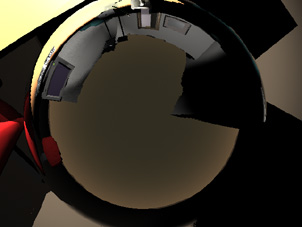
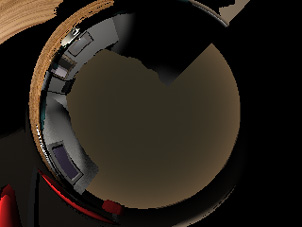
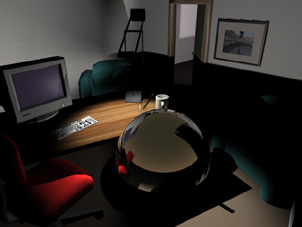
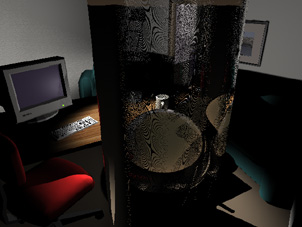
I recently saw an ad for one of the premiere modelling software systems, called Rhino, in which they recommended computer modellers investigate mold-making using computer software. That reminded me of some of the possibilities that are open to us as computer animators, besides logo's, billboard logo's, magazine logo's and web page logo's. The image above is from a test of a 3-D 360 degree surround system, using a sphere with a 100% reflectivity setting and a familiar office scene. In the first and second frames, the camera is looking down from above into the reflective sphere.
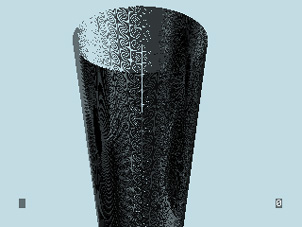
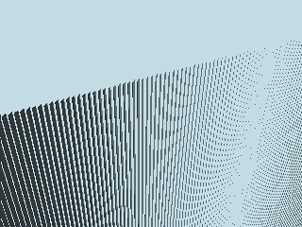
There is a major difference between the first and second frames, however, because not only is the first rotated some 45 degrees from the second (with a different tabletop), it is a stereo-optic partner to it, thanks to Ray Traced reflection. The rotation is due to a lenticular tube composed of 15,000 single-sided mirror polygons at an angle of 30-plus degrees to the plane of the diameter. The sixth image is a close-up of some of the 15,000 polygons making up the tube. I am really excited about this "Plug-in" because I have seen five different products based on converting "Christmas tree ball" 360 views into pan-able views that take less memory than virtual reality standards: an Australian inventor, www.adobe.com *, www.ipix.com *, www.quicktime.com *, and www.remotereality.com * which is not the catchiest name for a new technology company but which takes great shots. And 360 3-D might just be the next best thing!
There is also an "L-Script" which creates 360 degree views, and this method is resolution independent, at least as long as one has more mirrors present than horizontal pixels.
One may use only the sphere, and then the sphere and lenticular tube, in order to procure a good 360 3D pair, but one of the images will tend to be smaller than the other, due to the added distance of the lenticular mirrors. There will also be a slight difference in the geometry. This difference may be reduced by metamorphosing from a shallow to a steep angle for the lenticular mirrors, but to eliminate differences, the safest approach is to have the two views come from opposite angles, such as eight degrees left and eight degrees right for a sixteen degrees total. The lenticular tubes are parented to the sphere and interocular separation may be altered by sizing up or down as well.
Although I like this "Plug-In" for amusement park rides especially, two popular viewers appear to texture-map the loaded images onto the interior of a sphere, with the camera fixed in position at the center. The interface is apparently based on the VRML convention. Woo-hoo! Two other systems do the transformation using more conventional graphical translation means. IPIX* is very similar to "Christmas tree ball" optics, but with the camera shooting level instead of from above. There isn't currently a set viewing standard, but if VRML is stereo-optic, as I am told it is, then there should be some facility or jerry-rig capable of stereo surrounds or pans, as with Quicktime VR, such as alternating sphere animation cycles.
One doesn't have to use the sphere. Just panning the camera from inside the lenticular tube, then panning again without the tube, will give two stereoscopic panoramas, once the images are "sewn" together. I almost bought one of those programs that automatically montage images together. www.realviz.com has one program called "stitcher" for instance. I think I prefer the "L-Script" approach at this time. The lenticular tube is a much better stereo image producer for these kinds of pictures, because displacement tends to shift otherwise, so that the middle of a crowd will look flat while the edge people will be rounded.
So, want to test-drive the Beta version, anyone?Due to some file-loading problems at this website, it may be easier to use the "array" command in LIGHTWAVE to make your own lenticular tube. I have put it into the following 5 objects, one surface, and one scene files: Lensball , Lentube1 , Lentube2 , Lentube3 , Lentube4 , mirror.srf , and Sample are the basic components, currently configured for 360 hemispheres, but adaptable to full immersion renders. (If one makes their own mirror ball in INSPIRE or LIGHTWAVE, one can get-by with "Lentube1" and the last two files, which load quickly. Rotating "Lentube1" 180 degrees on the x or z axes gives one "Lentube3.") I apologize that I found it expedient to store the longer of these URL's as "zip" files, that need to be unzipped and renamed "lwo"s. Instructions for the 360 3D "Plug-in" may be found here . I will also gladly mail the files to you if there is a download problem, contact Scotttygett@juno.com . The images produced may be used for surround projection, like Disneyland's CircleVision 360 which I believe was an IWERKS project, or realtime stereoscopic viewing of individual frames by a Quicktime-type product or texture-mapping to the interior of spheres using the "Object Replacement" Plug-in (as processing speed allows) or an anaglyph Plug-in.
One can also construct stereoscopes for viewing the images, but they will not be "realtime," INSPIRE seems to reserve mirror reflection for rendering. Realtime viewing of 3D 360 animation, possibly using the VRML standard with metamorphosis (as processing speed allows) is another fun option. The sanity-burdened may ask "Why are you making a VR of a movie of a VR instead of just loading the objects?" My answer is that I envision this as a photographic system when the lenses become available. (Some links recently listed in an LA TIMES article about lenticular 3D may be found here.) Others might point out that it has some small speed advantage at high polygon counts.
In conclusion, returning to the point made at the beginning of this Gallery page, an INSPIRE artist is also a CAD artist. Programmers who may not know LIGHTWAVE will recognize AUTOCAD, and inventors everywhere know about AUTOCAD, one hopes. If one has an idea for a project, whether it is a tether to low earth-orbit or a design of children's swing, INSPIRE is probably ready to surprise once again. If one wonders what it would look like to have a lens the size of a car made out of plastic, one may not be able to get much of a grasp of distortions (chromatic) present, but the overall design and operation will be correct with ray-tracing INSPIRE. Do you have Leonardo-esque aspirations? How better to propose to other entrepreneurs your concept for a concave mirror 1 kilometer across for deuterium fusion? One really can prototype some amazing things using INSPIRE, in addition to software "plug-ins" far more ambitious than the example above.
All contents copyrighted Scott Lee Tygett c. 2000
* All names are registered and reserved to their respective owners, and this web page and product is in no way affiliated with Adobe, Quicktime, Newtek, Ipix, Remote Reality or others who may be listed here.
< BACK . . . . . . . . . . . . . . < HOME > . . . . . . . . . . . . . . NEXT >